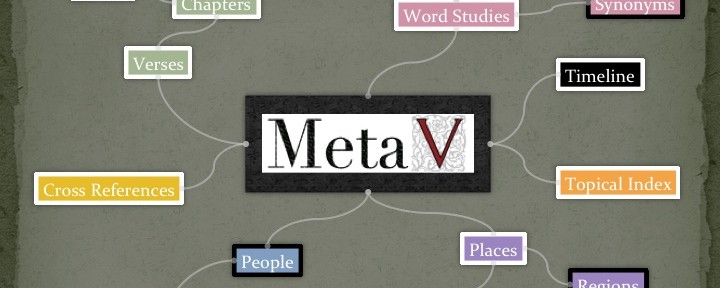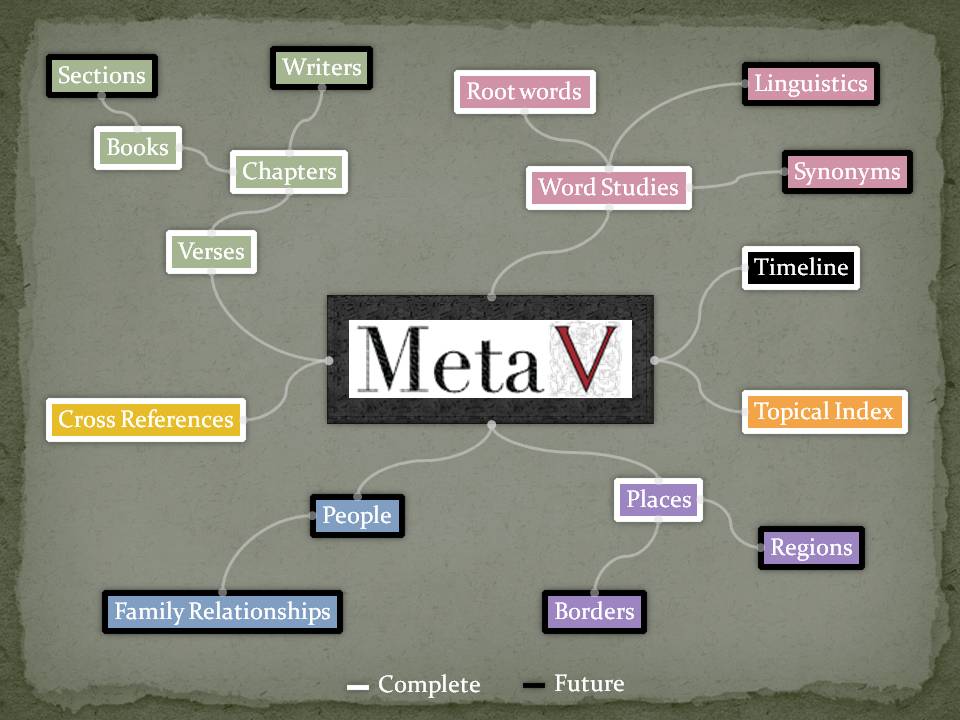This is the first in a series of posts outlining the roadmap for MetaV, a database of people, places, passages, and periods of time found in the Bible. Much work has gone into developing it, but there is much work left to do. There are gaps to be filled in, new data to add, and (most importantly) applications to be developed which aid in data exploration. This roadmap provides a thorough understanding of the improvements I currently envision. It does not include any timelines for completion of these ideas.
People
When we study the Bible and come across a person, we’d like to know a few basic things about that individual which provide some background for understanding his life and how his experiences relate to the story we’re reading. MetaV provides that context with family relationships, some basic biographical information, and explicit identification of the person named. As an example of the latter, consider that there are 26 unique individuals in the Bible named Zechariah. MetaV makes it clear whether that passage is talking about the well-known prophet or one of the other 25. Or, the opposite problem may occur in which one person goes by more than one name such as Paul (originally Saul) or God himself who goes by many names.
Unambiguous, Thorough Searching
To that end, some work remains in identifying names which are not always easy to process programmatically. These may include possessive forms (like “Aaron’s”) or in many cases where the name of a person is also used to describe a place (like Israel). Even more ambiguous are personal pronouns (him, hers, we, they, ours). We know they describe a person and can usually identify that person through normal exegesis. It is time we recorded that knowledge in order to build upon it.
By including that level of detail in MetaV, we will be able to find verses which refer to a group of people but never mention them by name. A good example would be Jesus’ disciples. Any place which references the “disciples”, “apostles”, “the twelve”, etc. would be a reference to Matthew, Mark, Luke, John, etc. even though they are not discussed by name. Unless and until this is defined at word-level detail many of these verses would not appear in search results for “Matthew” (or another disciple for this example) meaning the search would not return some pertinent references.
Biographical Details
Other things we’d like to know about people in a “quick reference” context window which are not yet defined in MetaV are: official title, occupation, name meanings, or even a brief summary of the person’s life. We would also like to know what books of the Bible that person may have written. Again in the case of Zechariah: are you reading about the person who wrote the book of Zechariah, or a different person with the same name? We also know the birth and death places for some people. Future revisions to MetaV will link these places to the “Places” table for more context.
Relationships
The relationships defined in MetaV today are limited to family relationships. But, we interact with others outside our family in the context of work, school, and play. People of the Bible are no different. A set of data defining these relationships for people in the New Testament already exists as part of the Semantic Bible project. This data can be integrated into MetaV and then expanded upon to include Old Testament figures.
People also form groups. The disciples are a group. The Israelites are a group. Much like today’s social networks which readily find a person’s group membership, MetaV currently has identified members of the 12 tribes of Israel and the people listed in Jesus’ genealogy. Clearly many more groups must be defined, but this is a good start.
Communication
The Bible is God’s communication to man. Within that, we see God talking to prophets, people talking to each other, and writers speaking to readers. Wouldn’t it be nice to clearly identify who is the sender of a message and who is the intended recipient? Well, the folks at Crossway have tackled the first part of that using Mechanical Turk. They produced a dataset identifying all the speakers of the Bible and, thankfully, released it publicly. Once it is “translated” to work with MetaV, I can begin the process to show recipients of what is being spoken (or written).
That’s all for now. Keep an eye out here to learn how we can improve upon data describing places and periods of time, or find out about the applications being developed to explore this data.




